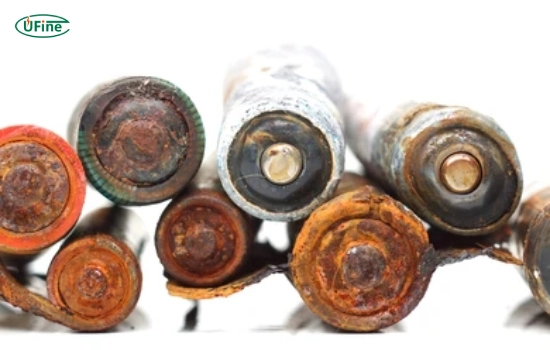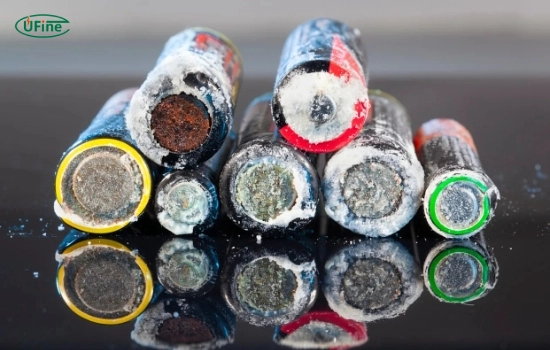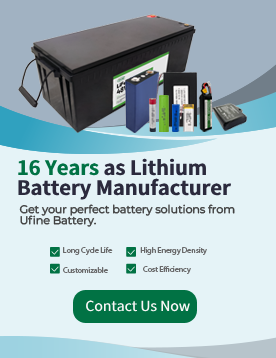
- Part 1. What is battery rust?
- Part 2. What is battery corrosion?
- Part 3. How to tell battery rust from battery corrosion?
- Part 4. Why should you care about rust or corrosion?
- Part 5. Visual differences of rust vs corrosion on terminals
- Part 6. How to remove battery corrosion safely?
- Part 7. How to treat and prevent battery rust?
- Part 8. How to prevent future rust and corrosion?
- Part 9. Why lithium batteries don't suffer from corrosion?
- Part 10. FAQs about battery rust vs corrosion
When you’re dealing with battery rust vs corrosion, knowing the difference is crucial to protect your vehicle or equipment. These two issues may look similar at first glance, but they come from very different causes and require different solutions. So, how can you tell them apart, and what should you do when you spot them?
Battery rust forms as a result of oxidation, usually on the metal parts exposed to air and moisture. Battery corrosion, on the other hand, is a chemical reaction often caused by leaking battery acid or gases. Both problems can ruin your battery’s performance and even cause it to fail completely if ignored.
In this article, we’ll break down the key differences between rust and corrosion, show you how to deal with each, and explain why newer lithium batteries are designed to avoid these issues in the first place.
Part 1. What is battery rust?
Battery rust is the reddish-brown flaky substance you might see on the metal casing or terminals of a battery. It happens when iron or steel parts oxidize in the presence of moisture and oxygen.
Rust is a slow process, mostly affecting vehicles or equipment stored in damp environments. If your battery terminals or the battery tray are made of iron or steel, they can rust over time, especially if water gets in.
How does rust form?
Rust forms through a chemical reaction known as oxidation. Here’s how it works:
- Iron or steel is exposed to oxygen in the air.
- If water or even just high humidity is present, this speeds up the process.
- The metal reacts to form iron oxide, commonly known as rust.
This reaction is purely physical and doesn’t involve the battery’s internal chemicals.
Part 2. What is battery corrosion?
Battery corrosion is a white, blue, or green powdery substance that builds up around the battery terminals. It’s not caused by moisture in the air but by chemical leaks or reactions, often from the battery acid.
This is especially common in lead-acid batteries, where hydrogen gas escapes during charging or discharging, reacting with other elements to form corrosive compounds.
How does corrosion occur?
Battery corrosion is caused by:
- Acid leakage from inside the battery
- Hydrogen gas reacting with metal and the air
- Poor connections or overcharging
Unlike rust, corrosion is a chemical reaction directly tied to the battery’s function.
Part 3. How to tell battery rust from battery corrosion?
Here’s a quick way to tell the difference between rust on battery terminals and corrosion:
| Feature | Rust | Corrosion |
|---|---|---|
| Color | Reddish-brown | White, green, or blue |
| Location | On iron or steel parts | Around battery terminals |
| Cause | Air + moisture + iron | Battery acid or hydrogen gas |
| Material | Iron oxide (Fe₂O₃) | Copper sulfate, lead sulfate, etc. |
| Texture | Flaky and rough | Powdery or crusty |
If you wipe the area and the residue is powdery and colored, you’re dealing with corrosion. If it’s hard and flaky, it’s most likely rust.
Part 4. Why should you care about rust or corrosion?
Both rust and corrosion can create serious problems for your battery and electrical system.
Effects of rust:
- Weakens metal parts
- May cause battery mounts or trays to fail
- Can spread to nearby parts
Effects of corrosion:
- Poor electrical contact
- Trouble starting the engine
- Battery won’t charge properly
- Terminal damage
Ignoring either issue can lead to costly repairs or even complete battery failure.
Part 5. Visual differences of rust vs corrosion on terminals
Let’s paint a clearer picture of how they look on your battery:
Rust on terminals:
- Often found on the battery tray or hold-down brackets
- Appears dark red or orange
- Feels rough and flaky
- Usually spreads slowly
Corrosion on terminals:
- Found directly on the battery posts or cable ends
- Appears white, green, or blue
- Feels powdery or chalk-like
- Can spread quickly if not treated
Part 6. How to remove battery corrosion safely?
Battery corrosion removal is easy if you follow safe steps. Here’s a simple method using household supplies.
What you’ll need:
- Gloves and eye protection
- Baking soda
- Water
- Old toothbrush or wire brush
- Petroleum jelly or terminal protector
Step-by-step guide:
- Turn off the vehicle or equipment.
- Disconnect the battery, starting with the negative terminal.
- Mix 1 tablespoon of baking soda with 1 cup of water.
- Dip the brush in the mix and scrub the corrosion.
- Rinse with clean water and dry with a cloth.
- Apply petroleum jelly or anti-corrosion spray to terminals.
- Reconnect the battery.
This method neutralizes the acid and stops further corrosion.
Part 7. How to treat and prevent battery rust?
Rust can be more stubborn than corrosion. Here’s how to handle it:
Tools and materials:
- Rust remover or vinegar
- Wire brush or sandpaper
- Rust-inhibiting primer or paint
Steps:
- Remove loose rust with a brush.
- Apply rust remover or soak in vinegar.
- Scrub until clean metal appears.
- Dry completely.
- Paint with rust-inhibitor to prevent it from returning.
You can also install rubber mats or protective covers to keep moisture away from metal parts.
Part 8. How to prevent future rust and corrosion?
Prevention is always better than repair. Here’s how to keep your battery clean and safe:
Tips to prevent corrosion:
- Use sealed or maintenance-free batteries.
- Apply dielectric grease or terminal protectors.
- Don’t overcharge your battery.
- Clean terminals every few months.
Tips to prevent rust:
- Store vehicles in dry environments.
- Coat vulnerable parts with rust-proof paint.
- Check for leaks or trapped water near the battery.
Regular inspection can save you from major damage.
Part 9. Why lithium batteries don’t suffer from corrosion?
Modern lithium-ion batteries are designed in ways that avoid both rust and corrosion. Here’s why:
- No acid is used, so no acid leaks
- Fully sealed enclosures
- No gas release during charging
- Casing materials are often non-metallic or rust-resistant
This makes lithium batteries a low-maintenance option for RVs, solar systems, marine use, and even cars.
They’re also lighter, last longer, and perform better in extreme temperatures. If you’re tired of cleaning corrosion, it might be time to switch to lithium.
Artikel Terkait: Why Lithium Batteries Don’t Rust
Part 10. FAQs about battery rust vs corrosion
What is the difference between battery rust and corrosion?
Rust is caused by oxygen and moisture reacting with iron. Corrosion is caused by chemical reactions, often from battery acid or gas. Rust is reddish and flaky, corrosion is white or green and powdery.
Is battery corrosion dangerous?
Yes. Corrosion can block electrical flow, damage terminals, and even cause battery failure. It also contains chemicals that can irritate skin and eyes.
Can rust or corrosion drain a battery?
Not directly, but they can interfere with charging or discharging, causing poor performance or premature battery death.
How often should I clean my battery terminals?
Every 3 to 6 months is a good rule, especially in older vehicles or harsh climates. Always check after long storage.
Should I replace a corroded battery?
If the corrosion is severe or keeps returning, it may be a sign your battery is leaking or failing. In that case, replacement is a better long-term solution.
Related Tags:
More Articles

Why Lithium Batteries Don’t Rust: Chemical Stability Explained
Learn why lithium batteries don’t rust. Their iron-free chemistry and moisture protection make them more corrosion-resistant than lead-acid or alkaline types.
Server Rack Battery vs UPS Battery: What’s the Difference
Discover the difference between server rack and UPS batteries. Compare design, chemistry, performance, and maintenance to select the best data center backup.
How to Choose the Right Server Rack Battery for Your Data Center?
Find out how to choose the right server rack battery for your data center. Consider capacity, runtime, safety, and compatibility for reliable backup power.
What Is a Server Rack Battery? A Complete Guide for Data Centers and IT
Discover what a server rack battery is, how it works, and why it’s essential for reliable data center and IT power backup. Learn key features and benefits.
Understanding the Difference Between AA and AAA Batteries
Wondering about the difference between AA and AAA batteries? Learn the key differences, similarities, and when to use each in this detailed guide.




